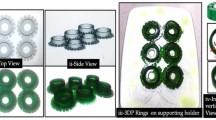Abstract
The performance of polymer artifacts is adversely affected if degradation occurs during the various stages of polymer manufacture, fabrication, and subsequent exposure to the environment. Molecular oxygen is the major cause of polymer degradation and is responsible for the ultimate mechanical failure of polymer artifacts. The deleterious effect of molecular oxygen is accelerated by many other factors: sunlight; heat; ozone; atmospheric pollutants; water; mechanical stress; adventitious metal and metal ion contaminants.
Access this chapter
Tax calculation will be finalised at checkout
Purchases are for personal use only
Preview
Unable to display preview. Download preview PDF.
Similar content being viewed by others
References
Scott, G. (1993) Atmospheric Oxidation and Antioxidants, Vol. 1 (ed. G. Scott), Elsevier Applied Science, London and New York, pp. 121–160.
Al-Malaika, S. (1993) Atmospheric Oxidation and Antioxidants, Vol. 1 (ed. G. Scott), Elsevier Applied Science, London and New York, pp. 161–224.
Scott, G. (1993) Atmospheric Oxidation and Antioxidants, Vol. 2 (ed. G. Scott), Elsevier Applied Science, London and New York, pp. 141–218.
Gugumus, F. (1980) Oxidation Inhibition of Organic Materials, Vol. 2 (eds P. Klemchuk and J. Pospisil), CRC Press, Boca Raton, pp. 29–162.
Billingham, N.S. (1993) Atmospheric Oxidation and Antioxidants, Vol. 2 (ed. G. Scott), Elsevier Applied Science, London and New York, pp. 219–278.
Al-Malaika, S. (1993) Macromolecules — 1992 (ed. J. Kahovec), VSP, he Netherlands, pp. 501–515.
Al-Malaika, S. and Issenhuth, S. (1996) Advances in Chemistry Series — 249 (eds R.L. Clough, K.T. Gillen and N.C. Billingham), ACS, Washington, pp. 425–440.
Scott, G. (1993) Atmospheric Oxidation and Antioxidants, Vol. 2 (ed. G. Scott), Elsevier Applied Science, London and New York, pp. 431–460.
Editor information
Editors and Affiliations
Rights and permissions
Copyright information
© 1998 Springer Science+Business Media Dordrecht
About this chapter
Cite this chapter
Al-Malaika, S. (1998). Antioxidants: an Overview. In: Pritchard, G. (eds) Plastics Additives. Polymer Science and Technology Series, vol 1. Springer, Dordrecht. https://doi.org/10.1007/978-94-011-5862-6_8
Download citation
DOI: https://doi.org/10.1007/978-94-011-5862-6_8
Publisher Name: Springer, Dordrecht
Print ISBN: 978-94-010-6477-4
Online ISBN: 978-94-011-5862-6
eBook Packages: Springer Book Archive




